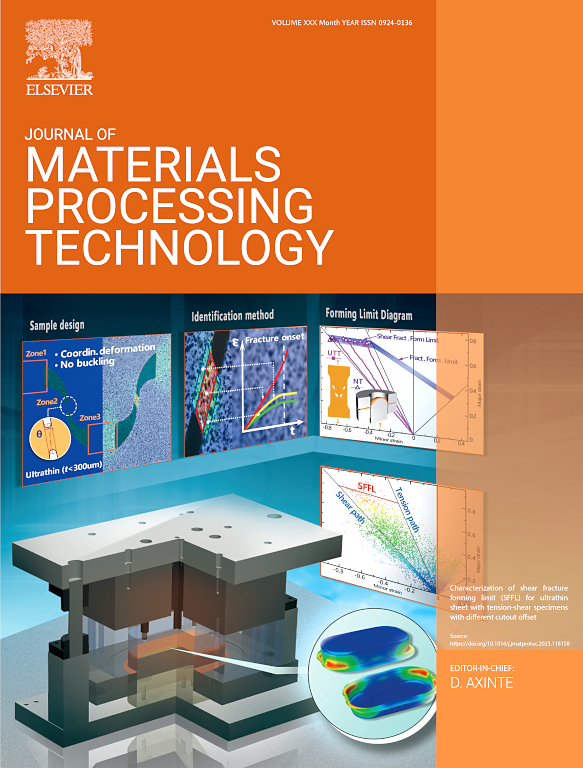Bi-directional scanning strategies for residual stress management by tailoring microstructural evolution in directed energy deposition of 9Cr-1Mo steel
IF 6.7
2区 材料科学
Q1 ENGINEERING, INDUSTRIAL
Journal of Materials Processing Technology
Pub Date : 2025-05-19
DOI:10.1016/j.jmatprotec.2025.118906
引用次数: 0
Abstract
The transient heating and cooling cycles in arc-based directed energy deposition (DED) processes play the critical role in defining the microstructure and mechanical performance of nuclear-grade steel (9Cr-1Mo) deposition. The current study establishes a comprehensive framework that advances the underlining physics of thermal gradients, phase transformations, and residual stress evolution during the DED process. By combining finite element (FE) simulation and microstructural analysis, the study demonstrates a ∼17 % reduction in tensile residual stress along the build direction following optimized bi-directional scanning strategies. Thermodynamic modeling using the Scheil-Gulliver approach elucidates the formation of key phases, such as δ-ferrite, martensite, and precipitates (M23C6 and MX), under non-equilibrium conditions inherent to DED process. These findings reveal that non-equilibrium cooling suppresses δ-phase formation, promotes a martensitic matrix, and tailors cellular or dendritic morphologies decisive for mechanical performance. Transmission electron microscopy (TEM) analysis highlights that bi-directional scanning refines martensitic laths, reduces dislocation tangles, and promotes uniform carbide precipitation, significantly enhance microstructural stability and material performance. The current work not only shows the ways of mitigating Type IV cracking through stress reduction and microstructural control but also provides a transferable framework for tailoring deposition strategies in ferritic/martensitic steels and other high-performance materials suitable for industrial applications.
定向能沉积9Cr-1Mo钢的双向扫描残余应力管理策略
电弧定向能沉积(DED)过程中的瞬态加热和冷却循环对核级钢(9Cr-1Mo)沉积的显微组织和力学性能起着关键作用。目前的研究建立了一个全面的框架,推进了DED过程中热梯度、相变和残余应力演化的基础物理。通过结合有限元(FE)模拟和微观结构分析,该研究表明,在优化的双向扫描策略下,沿构建方向的拉伸残余应力降低了~ 17 %。使用Scheil-Gulliver方法的热力学模型阐明了在DED过程固有的非平衡条件下形成的关键相,如δ-铁素体、马氏体和沉淀(M23C6和MX)。这些发现表明,非平衡冷却抑制了δ相的形成,促进了马氏体基体的形成,并调整了对机械性能起决定性作用的细胞或枝晶形态。透射电镜(TEM)分析表明,双向扫描细化了马氏体板条,减少了位错缠结,促进了碳化物的均匀析出,显著提高了显微组织的稳定性和材料的性能。目前的工作不仅展示了通过减少应力和控制微观结构来减轻IV型裂纹的方法,而且还为铁素体/马氏体钢和其他适用于工业应用的高性能材料的定制沉积策略提供了可转移的框架。
本文章由计算机程序翻译,如有差异,请以英文原文为准。
求助全文
约1分钟内获得全文
求助全文
来源期刊

Journal of Materials Processing Technology
工程技术-材料科学:综合
CiteScore
12.60
自引率
4.80%
发文量
403
审稿时长
29 days
期刊介绍:
The Journal of Materials Processing Technology covers the processing techniques used in manufacturing components from metals and other materials. The journal aims to publish full research papers of original, significant and rigorous work and so to contribute to increased production efficiency and improved component performance.
Areas of interest to the journal include:
• Casting, forming and machining
• Additive processing and joining technologies
• The evolution of material properties under the specific conditions met in manufacturing processes
• Surface engineering when it relates specifically to a manufacturing process
• Design and behavior of equipment and tools.
 求助内容:
求助内容: 应助结果提醒方式:
应助结果提醒方式:


